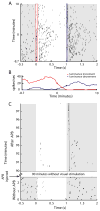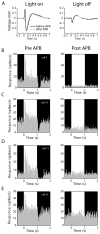Rapid plasticity of visual responses in the adult lateral geniculate nucleus
- PMID: 21903075
- PMCID: PMC3170518
- DOI: 10.1016/j.neuron.2011.06.025
Rapid plasticity of visual responses in the adult lateral geniculate nucleus
Abstract
Compared to the developing visual system, where neuronal plasticity has been well characterized at multiple levels, little is known about plasticity in the adult, particularly within subcortical structures. We made intraocular injections of 2-amino-4-phosphonobutyric acid (APB) in adult cats to block visual responses in On-center retinal ganglion cells and examined the consequences on visual responses in the lateral geniculate nucleus (LGN) of the thalamus. In contrast to current views of retinogeniculate organization, which hold that On-center LGN neurons should become silent with APB, we find that ∼50% of On-center neurons rapidly develop Off-center responses. The time course of these emergent responses and the actions of APB in the retina indicate the plasticity occurs within the LGN. These results suggest there is greater divergence of retinogeniculate connections than previously recognized and that functionally silent, nonspecific retinal inputs can serve as a substrate for rapid plasticity in the adult.
Copyright © 2011 Elsevier Inc. All rights reserved.
Figures




Similar articles
-
Functional consequences of neuronal divergence within the retinogeniculate pathway.J Neurophysiol. 2009 Apr;101(4):2166-85. doi: 10.1152/jn.91088.2008. Epub 2009 Jan 28. J Neurophysiol. 2009. PMID: 19176606 Free PMC article.
-
The connections of the retinal on and off pathways to the lateral geniculate nucleus of the monkey.Vision Res. 1984;24(9):923-32. doi: 10.1016/0042-6989(84)90067-1. Vision Res. 1984. PMID: 6506480
-
The Augmentation of Retinogeniculate Communication during Thalamic Burst Mode.J Neurosci. 2019 Jul 17;39(29):5697-5710. doi: 10.1523/JNEUROSCI.2320-18.2019. Epub 2019 May 20. J Neurosci. 2019. PMID: 31109958 Free PMC article.
-
Binocular response modulation in the lateral geniculate nucleus.J Comp Neurol. 2019 Feb 15;527(3):522-534. doi: 10.1002/cne.24417. Epub 2018 Mar 9. J Comp Neurol. 2019. PMID: 29473163 Free PMC article. Review.
-
Mapping the primate lateral geniculate nucleus: a review of experiments and methods.J Physiol Paris. 2014 Feb;108(1):3-10. doi: 10.1016/j.jphysparis.2013.10.001. Epub 2013 Nov 21. J Physiol Paris. 2014. PMID: 24270042 Free PMC article. Review.
Cited by
-
Synchrony of Spontaneous Burst Firing between Retinal Ganglion Cells Across Species.Exp Neurobiol. 2020 Aug 31;29(4):285-299. doi: 10.5607/en20025. Exp Neurobiol. 2020. PMID: 32921641 Free PMC article.
-
Development of Functional Properties in the Early Visual System: New Appreciations of the Roles of Lateral Geniculate Nucleus.Curr Top Behav Neurosci. 2022;53:3-35. doi: 10.1007/7854_2021_297. Curr Top Behav Neurosci. 2022. PMID: 35112333 Review.
-
Melanopsin-driven increases in maintained activity enhance thalamic visual response reliability across a simulated dawn.Proc Natl Acad Sci U S A. 2015 Oct 20;112(42):E5734-43. doi: 10.1073/pnas.1505274112. Epub 2015 Oct 5. Proc Natl Acad Sci U S A. 2015. PMID: 26438865 Free PMC article.
-
Refinement of Spatial Receptive Fields in the Developing Mouse Lateral Geniculate Nucleus Is Coordinated with Excitatory and Inhibitory Remodeling.J Neurosci. 2018 May 9;38(19):4531-4542. doi: 10.1523/JNEUROSCI.2857-17.2018. Epub 2018 Apr 16. J Neurosci. 2018. PMID: 29661964 Free PMC article.
-
An evolving view of retinogeniculate transmission.Vis Neurosci. 2017 Jan;34:E013. doi: 10.1017/S0952523817000104. Vis Neurosci. 2017. PMID: 28965513 Free PMC article. Review.
References
Publication types
MeSH terms
Substances
Grants and funding
LinkOut - more resources
Full Text Sources
Miscellaneous

